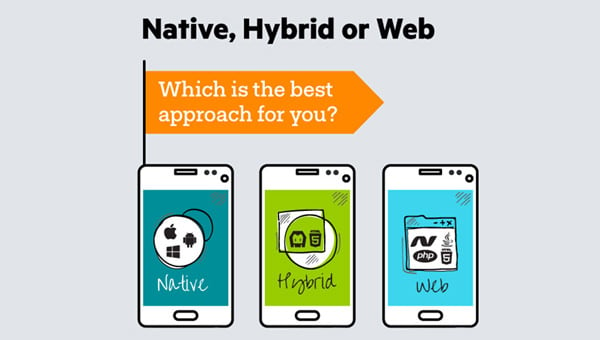Unleashing The Thin Line Between A Mobile Web App, Native App & Hybrid App
In this mobile age, the rapidly developing technologies have enabled businesses to efficiently reach a gigantic audience base and generate a great revenue. Moreover, the fact that the dominating mobile traffic surpasses the desktop traffic on the Internet has certainly encouraged businesses to embrace a mobile solution. (17+ Extraordinary Mobile & Web App Templates)

No doubt, the mobile applications are in rage today, as it offers a fabulous way to disseminate information. They allow one to effectively and efficiently target a whopping number of audiences and benefit his business. Moreover, there are several types of applications (like business, entertainment, health, news, and education, to name a few) that are developed by organizations to create an outstanding mobile presence.
The applications can be broadly categorized under three different sections, namely – native applications, web applications, and Hybrid applications.

Most of the people often get confused among the type of applications that they should opt to reap the utile benefits of the flourishing mobile and web technologies. In this article, we will delve deep into the three types and help you scrutinize your choice by differentiating each on the basis of certain factors.
Let’s begin by throwing some light on each mobile application development approach.
1. Native Application
These apps are specifically developed to target a mobile platform like Android (30+ Best Android App UI Designs), Windows Phone, iOS, Blackberry, etc., via mobile some OS specific app development tools. Although developers can implement resourceful frameworks and APIs that best cater to the needs of their project, they can’t port the same code on other mobile platforms. Native apps are the applications available in the app stores, and they can also integrate the native functionality of a target mobile device.
2. Web Application
Mobile web-application websites are designed and built with the help of browser-specific language (such as CSS, JavaScript, and HTML). They need web-browser compatibility in order to run and operate hassle-free on one or many mobile operating systems. A mobile website and mobile web app are two different thing: former is read-only and the latter is read-write enabled.
3. Hybrid Application
Hybrid app is a combination of the native and mobile web application. It can be downloaded from the application stores available out there. Although it encompasses certain attributes of a native app, (unlike native applications) they are not developed using native tools and technologies. They can be easily developed by implementing a suitable framework (like PhoneGap, Ionic, etc.), and a single code base that can run over various platforms. This methodology, thus, helps generate cross platform applications.
Now, let’s consider various factors and scour the behavior of these mobile app development methods.

-
UI Consistency
– Although the advancement in technologies has enabled one to develop a mobile web app and hybrid app with native look and feel, still there is certain difference between them. Furthermore, the frameworks that empower one to create native-like UI elements are also required to stay updated with the latest design updates of the major mobile OS. Native applications boasts genuine UI components, which are familiar to users. (8 Android UX Design Tools and Become A Great App Designer)
-
Performance
– Undoubtedly, native code offers the best approach to generate expeditious performance. While, the performances of mobile web and hybrid applications substantially depend upon the technique and tools used to interact with the native platform. Their performances can be augmented with the agile JavaScript engines, and by integrating WebKit’s overflow scrolling.
-
Cross Platform Compatible
– Since, the native apps are not portable to other mobile platforms, they don’t support multiple mobile OS. Whereas, hybrid and mobile web applications follow a similar approach by using a single codebase that can run seamlessly on major mobile operating systems.
-
Access to device features
– For this aspect, native apps again make a hit for obvious reasons. Mobile web applications have a limited access to device-specific features, though the GPS function is accessible, and can’t harness any background process. W3C is drafting new standards in this direction, but will take time before we have any significant result. As far as hybrid apps are concerned, their frameworks have dramatically improved to get access to various mobile APIs, including accelerometer.
-
Development Cost
– On comparing all the three approaches, it can be observed that when the native app method is used to develop applications for different platforms, the cost of development is certainly high. However, this can’t be gainsaid that developing a high-end mobile web application also demands a hefty investment. Thus, it is better to consider the quality over cost while choosing a type of mobile app development methodology.
Reflection
Like “every coin has two faces”, all the three types of mobile applications have their own upsides and downsides, which make them different from each other. It is completely an individual choice to pick either of the options. However, it is advisable to take the aforementioned factors and your business objectives into account to ensure a resourceful approach. Develop an innovative, intuitive and highly functional mobile app that stands out among the pool of applications to proficiently leverage your business.






